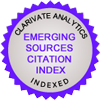The use of carbon obtained by carbonization of paper mill sludge waste in the adsorption of Cd(II) ions from aqueous solutions
Çiğdem Er Çalışkan1, Harun Çiftçi21Department Of Field Crops, Agriculture Faculty, Kirsehir Ahi Evran University, Kirsehir, Turkey2Department of Medical Biochemistry, Faculty of Medicine, Kirsehir Ahi Evran University, Kirsehir, Turkey
In this study, in which the adsorption of Cd (II) ions from aqueous solutions with the carbonization product obtained from the carbonization of paper mill waste sludge at different temperatures for two hours, it was observed that the adsorption efficiency increased with the increase of the carbonization temperature. The adsorption efficiency of Cd (II) ions depends largely on the pH of the environment. By contacting the 100 mg/L solution of Cd (II) with the carbonization product at 300, 400 and 500 0C at a dose of 5 g/L for 240 minutes at pH 5.5, the current Cd (II) ions were 45.3%, 52.4% and 61% removed. These values increased to 56%, 65.3% and 73.4% when the initial concentration of Cd (II) ions was taken as 50 mg/L. When the dose was applied as 20 g/L for the initial concentration of 100 mg/L, all of the existing Cd (II) ions (except the carbonization product at 300 0C) were adsorbed. The results obtained for each carbonization product were applied to the Langmuir and Freundlich isotherms. The cadmium adsorption kinetics were defined with a second order model and the cadmium adsorption isotherm was determined to fit the Langmuir model better. The applicability of the results to the isotherm equations and the changes in the value of the isotherm constants depending on the carbonization temperature were examined.
Keywords: Paper Mill Sludge Waste, Adsorption, Activated carbon, Carbonization, Cd (II) removal.Sulu çözeltilerden Cd(II) iyonlarının adsorpsiyonunda kağıt fabrikası çamur atığının karbonizasyonu ile elde edilen karbonun kullanımı
Çiğdem Er Çalışkan1, Harun Çiftçi21Kırşehir Ahi Evran Üniversitesi Ziraat Fakültesi, Tarla Bitkileri Ana Bilim Dalı, Kırşehir2Kırşehir Ahi Evran Üniversitesi, Tıp Fakültesi, Tıbbi Biyokimya Ana Bilim Dalı, Kırşehir
Kağıt fabrikası çamur atığının (KFÇA) farklı sıcaklıklarda iki saat süre ile karbonizasyonundan elde edilen karbonizasyon ürünü ile sulu çözeltilerden Cd(II) iyonlarının adsorpsiyonunun incelendiği bu çalışmada, karbonizasyon sıcaklığının artmasıyla adsorpsiyon veriminin arttığı gözlenmiştir. Cd(II) iyonlarının adsorpsiyon verimi büyük ölçüde ortamın pHsına bağlıdır. 100 mg/Llik Cd(II) çözeltisinin 5 g/L dozunda 300, 400 ve 500 0Cdeki karbonizasyon ürünü ile 240 dakika süre ile pH 5.5da temas ettirilmesiyle mevcut Cd(II) iyonlarının sırasıyla %45.3, %52.4 ve %61i giderilmiştir. Bu değerler Cd(II) iyonlarının başlangıç konsantrasyonu 50 mg/L olarak alındığında %56, %65.3 ve %73.4e yükselmiştir. 100 mg/Llik başlangıç konsantrasyonu için doz 20 g/L olarak uygulandığında ise mevcut Cd(II) iyonlarının tamamı (300 0Cdeki karbonizasyon ürünü hariç) adsorplanmıştır. Her karbonizasyon ürünü için elde edilen sonuçlar Langmuir ve Freundlich izotermlerine uygulanmıştır. Kadmiyum adsorpsiyon kinetiği, ikinci dereceden bir model ile tanımlandı ve kadmiyum adsorpsiyon izotermi, Langmuir modeline daha iyi uyduğu belirlendi. Sonuçların izoterm denklemlerine uygulanabilirliği ve izoterm sabitlerinin değerinin karbonizasyon sıcaklığına bağlı olarak değişimleri irdelenmiştir.
Anahtar Kelimeler: Kağıt Fabrikası Çamur Atığı, Adsorpsiyon, Aktif karbon, Karbonizasyon, Cd(II) giderimi.Manuscript Language: Turkish






